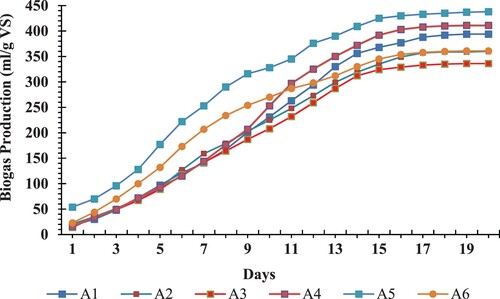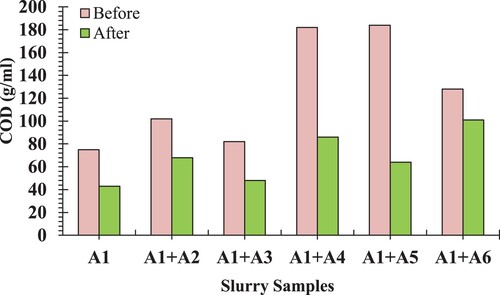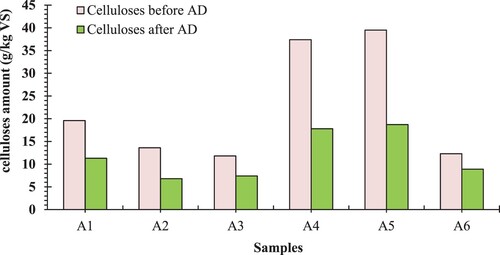 ?Mathematical formulae have been encoded as MathML and are displayed in this HTML version using MathJax in order to improve their display. Uncheck the box to turn MathJax off. This feature requires Javascript. Click on a formula to zoom.
?Mathematical formulae have been encoded as MathML and are displayed in this HTML version using MathJax in order to improve their display. Uncheck the box to turn MathJax off. This feature requires Javascript. Click on a formula to zoom.Abstract
The objective of the present work was to investigate the influence of co-digestion of agricultural waste, food and kitchen waste and municipal solid waste with animal manure for enhanced biogas production. Cow dung has been used for the generation of biogas, but complete depolymerization is not obtained till now. So, it is codigested with other substrates to increase the depolymerization of substrates. So, co-digestion of selected substrates withcow dung has been performed. Results show that co-digestion of cow-dung with lignocellulosic biomass is good for the enhancement of bio-energy production. This has been suggested by a decrease in COD is 42.66%, 28.42%, 41.46%, 52.74%, 65.21% and 21.09% for cow dung slurry, a combination of cow dung with vegetable waste, kitchen waste, rice straw, wheat straw and municipal waste, respectively. The maximum decrease in TOC of 51.28% and 41.18% in wheat straw and rice straw sample, respectively, suggests the highest biodegradability.
GRAPHICAL ABSTRACT
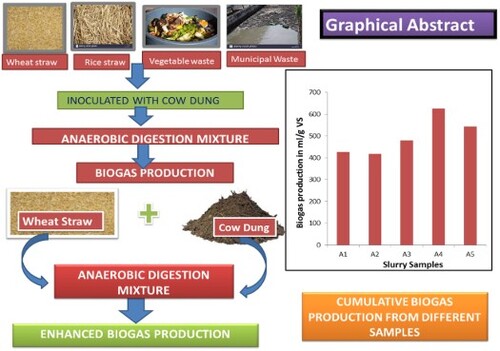
1. Introduction
Energy is the fundamental factor for the growth and development of a country. Improvement in industrialization and digitalization create serious problems of enhanced energy demand in every aspect. As the conventional sources of energy are progressively depleting, the requirement of consumption for renewable energy sources is increasing day by day [Citation1]. Researchers have been working on different biomasses to achieve their maximum potential. This idea of converting waste biomass to energy deals with energy meet and maintenance of environment by waste management. A lot of waste biomasses, such as agricultural and forest lignocellulosic biomass wastes, animal manure, municipal solid wastes, domestic waste, food waste, waste edible oil, dairy effluent etc., have been reported till now to convert into different types of biofuel depending upon their constituents [Citation2]. Biogas is a flammable, potentially energy converter and docile bio-energy product. As the main constituents of biogas are CH4 and CO2,greenhouse gases; thus the use of biogas as an energy source helps reduce the Green House effect that occurs due to excess of CO2 and naturally emission of biogas in the environment from animal manure, open municipal wastes, marshes, etc. [Citation3]. Anaerobic digestion is a biochemical process in which degradation of organic matter has been done by micro-organisms under oxygen-free conditions and generates biogas of about 50–75% methane and 25–50% carbon dioxide [Citation4]. As this process includes the depolymerization of higher molecules into smaller ones by micro-organisms, a proper channel and conditions help the microbes to perform well [Citation5]. This process can be divided into four main steps : hydrolysis, acetogenesis, acidogenesis, and methanogenesis (X. [Citation6]). As hydrolysis of celluloses is the rate-controlling step in the anaerobic digestion, this step should be performed to get the maximum output from the substrate or biomass. Various biomasses such as animal feces, agricultural waste, municipal waste, dairy wastewater etc., have been to produce biogas [Citation7]. A combination of different biomasses to enhance their biodegradability and depolymerization for anaerobic digestion is called co-digestion [Citation8–10]. Cow dung has been used for a very long time for the generation of biogas, but complete depolymerization and decomposition of biogas is not obtained till now. So, there is a need for its co-digestion with other substrates so that maximum yield can be attained by enhancing the depolymerization of substrates. Till now, lots of work on enhancing biogas production with the help of digestion of substrates have been reported [Citation11–14]. Cow dung has low carbohydrates, but is a good source of methanogens [Citation15]. It contains a high nitrogen value, so it has a low C/N ratio required for the anaerobic digestion [Citation16]. Thus, such a substrate is needed for combination with cow dung that contains a sufficient amount of organic matter. Various organic biomasses are available for co-digestion with cow dung; among these, agricultural waste (rice straw and wheat straw), vegetable waste, kitchen waste and municipal waste are chosen to cover up the maximum variety of organic matter. Agricultural waste comprises lignocellulosic material, i.e. cellulose 30–40%, hemicellulose 20–25%, and lignin 20–25%. The anaerobic biodegradation of lignocellulosic material is limited due to its complex structure; cellulose and hemicelluloses are tightly bound to lignin preventing microbial degradation under anoxic conditions. Methanogens from animal manure can help destroy the lignin structure of lignocellulosic biomasses, hence the process of co-digestion improves anaerobic digestion [Citation17]. Similarly, Kitchen waste, vegetable and fruit waste, and municipal solid wastes include all types of waste generated by us daily, and are a good source of organic wastes. These organic wastes undergo anaerobic digestion only when co-digestion with a methanogenic source has been done. So co-digestion of different waste biomasses and animal manure provides a good balance of the C/N ratio of substrates to undergo anaerobic digestion [Citation18]. This experimental study aims to investigate the biogas potential of cow-dung when co-digested with agro-food wastes and municipal waste. This leads to an analysis of the characterization and potential of selected substrates and the effect of co-digestion of different biomasses with cow-dung on biogas production by anaerobic digestion.
2. Materials and methods
2.1. Collection of substrate and inoculum
Lignocellulosic biomass, such as wheat straw and rice straw ,was collected from the crop field near the rural area of Faridabad district, Haryana (India). Sludge and Fruit-Vegetable and Food waste were collected from the sewage treatment plant and cafeteria, respectively, in Manav Rachna University, Faridabad. The cow dung for inoculation for anaerobic digestion was collected from a Dairy farm in Faridabad. The inoculum was kept in air-tight containers at 4°C and acclimated at 30 ± 2°C for one week, before applying for anaerobic digestion.
2.2. Analytical procedure
Parameters, such as pH, Total Solids (TS), Total Kjeldhal Nitrogen (TKN), Volatile Solids(VS), Total Organic Carbon (TOC), and Chemical Oxygen Demand (COD), were analyzed for the characterization of collected substrates. The analysis of TS involves drying the sample in the oven at 105°C for four hours and placed in desiccators. The difference in weight of the sample was measured to calculate TS. The volatile solid was determined by the mass of the sample remaining after heating the dried, milled sample at 550°C for 4 h (APHA, 2012). The TS and VS of the substrate were determined before and after anaerobic digestion by the 2540B (APHA, 2012) method. TOC (Walkey and black, 1934), Total Nitrogen 4500-C (APHA, 2012), and Chemical Oxygen Demand Open Reflux Method (COD) by 5220B (APHA, 2012) of the substrate were analyzed. The pH value was detected by a digital pH metre (CpH-102). The celluloses, hemicelluloses, and lignin were extracted using acid detection and the Tappi T222 om-88 method [Citation19].
2.3. Batch tests
All substrates were digested in anaerobic digesters under mesophilic conditions (30-40°C). The total volume of each bottle used as a digester was 1 L with a working volume of 0.6 L. In every digester, cow dung was used as inoculum, and distilled water was used to top up the volume. The substrate was first placed in each digester, then inoculums were added with water required to fill the digester to the working volume of 0.6 L. Each digester contained 20 g dry matter of the substrate and 20 g of cow dung. The inoculums were adopted according to the study of (R. [Citation20]). All digesters were manually shaken twice a day for about 1 min. All digesters were set up in the laboratory, and the production of biogas was estimated by water displacement methods. Changes in pH, COD and TOC were evaluated from different slurries at the 1st, 5th, 10th, 15th, and 20th day of digestion [Citation21]. The particular details of Hydraulic retention time (HRT), substrate concentration, temperature, C/N ratio, and substrate-inoculums ratio were assessed and given in Table , which shows that the digesters were set up for 20 days to attain the results. The experiment was performed in triplicate using the same substrate to inoculums ratio as per suggested by [Citation21] Table .
Table 1. Anaerobic digester set-up details.
2.4. Biodegradability analysis
Biodegradability of substrates can be shown in the change in COD or TOC or celluloses of the substrates at different intervals of the anaerobic digestion process. The value of COD indicates about the energy content of the feed-stock by indicating the amount of material that can be chemically oxidized [Citation22]. Thus the greater the COD change during the anaerobic digestion, the higher the biodegradability of the feed-stock. So, the slurry was checked at intervals of 1st, 5th, 10th, 15th, and 20th days and the change was calculated.
2.5. Kinetic study of biogas production
To understand the influence of alkaline pretreatment on biogas production modified Gompertz model was used to evaluate the cumulative biogas production [Citation23].
(1)
(1) where Y (t) is the cumulative biogas yield (ml) for time t (days), P is the maximum biogas production potential (ml), µm is the maximum biogas production rate (ml/day), λ is the lag phase (days). Evaluation of kinetic parameters is essential for the optimal digester design and efficient operation of large-scale biogas plants. In the present study, the equation was estimated using a non-linear curve fitting using PAST 4.03 statistical software.
2.6. Statistical analysis
Experimental data shown in this study are the mean of three measurements. Standard deviation and Pearson correlation of operating parameters were analyzed using Microsoft Excel. To understand the influence of co-digestion, instead of a single substrate on biogas production, analysis of variables (ANOVA) and non-linear regression were used to evaluate the cumulative biogas production.
3. Results and discussion
3.1. Characteristics of substrates
The characteristics of the studied substrates are shown in Table .
Table 2. Physiochemical characterizations of substrates.
Kitchen waste, vegetable waste, and municipal solid waste showed lower VS/TS values (12%-25.6%) than lignocellulosic feed-stock with values (75.9%-86.23%). For methane production, higher values of VS/TS are preferable [Citation24]. For best yields, the range of C/N should be 20–30 [Citation25]. Thus, lignocellulosic biomass attains this range when co-digested with cow dung due to the high nitrogen content in cow dung. Also, TOC, COD, cellulose, and hemicellulose contents are good in lignocellulosic biomasses as shown in Table . Lignin structure is very hard and complicated, which hinders the accessibility of cellulose to hydrolytic enzymes, so it should be with a limited amount [Citation26]. The amount of lignin is lsser in wheat straw than rice straw. Thus, pre-digestion characterization of biomasses helps improve the output of the experimental study. The COD of cow dung and vegetable and fruit waste is low, but that of lignocellulosic biomasses and kitchen waste is quite high. A high value of COD shows a higher amount of biodegradable matter. TOC% is the amount of carbon in substrates. A higher TOC value results in biodegradation enhancing products. TOC% value is maximum in lignocellulosic biomasses. Also, the amount of celluloses and hemicelluloses is quite enough in lignocellulosic biomasses and very low in other substrates.
3.2. Biogas potential of cow-dung with and without co-digestion
As anaerobic digestion is a chemical-microbial reaction on the substrate. The co-digestion of substrates improves results [Citation27,Citation28]. Cow dung and other substrates are taken in 1:1 with selected substrates, which improves the C/N ratio of substrates as the ideal range of C/N ratio vary 20–30 for the process of anaerobic digestion [Citation29]. In 20 days of the anaerobic process, daily and cumulative biogas production was noted and found that cow-dung co-digested with wheat straw showed the highest methane yield of 459 ml/g VS, followed by co-digestion with rice straw with 424 ml/g VS while co-digestion with vegetables and fruits waste showed the lowest 308 ml/g VS. Also, co-digestion of cow-dung with Kitchen waste and municipal solid wastes showed low yields (336 and 361 ml/g VS respectively), which were even less than the biomethane yield of cow-dung without co-digestion (394 ml/g VS). The cumulative productions of different anaerobic digestion setups are shown in Figure , which shows that co-digestion of cow-dung with lignocellulosic biomass is good for enhancing bio-energy production. That also proves that co-digestion of animal manure with other substrates give multiple benefits as the remaining effluent has good nutritional value [Citation30]
3.2.1. Effect of co-digestion on biodegradability of substrates
Figure shows the initial and final value of the COD of slurries. The value of COD for the combination of cow dung with wheat straw and rice straw has been changed from 184 mg/l to 64 and 182 mg/l to 86 mg/l, respectively. These are followed by cow dung slurry, a combination of CD with vegetable waste, kitchen waste and municipal waste, respectively. Net decrease in COD is 42.66%, 28.42%, 41.46%, 52.74%, 65.21% and 21.09% for A1, A1 + A2, A1 + A3, A1 + A4, A1 + A5 and A1 + A6 slurry samples, respectively. The figure shows the change in initial and final values of COD in various set-ups and concludes that co-digestion of lignocellulosic biomasses with animal manure has maximum degradability due to the maximum change in COD value.
Similarly, TOC is the total amount of carbon in the feed-stock, which shows its conversion in bio-energy. Thus the greater the TOC of feed-stock consumed by the anaerobic digestion, the higher is the biodegradability of feed-stock. Table shows the maximum decrease in TOC of 51.28% and 41.18% in wheat straw and rice straw samples, respectively. The higher the TOC of substrate, the higher is the organic content of substrate, and the higher the chances of depolymerization. This increases the biodegradability of substrates and hence the yield of the anaerobic digestion process. Thus, lignocellulosic biomasses are more biodegradable than kitchen waste, vegetable waste, cow dung, and municipal solid waste.
Table 3. Changes in TOC of Samples before and after anaerobic digestion.
Celluloses are the main constituent of all types of substrates that undergo sepolymerization to produce methane [Citation31]. Thus, the change in the quantity of celluloses tells about how much a feed-stock has been converted into bio-energy. Figure shows that lignocellulosic biomasses have maximum celluloses and also maximum consumption of celluloses as compared to other feed-stocks. Consumption of celluloses is 52.65% and 52.40% in Wheat straw and Rice straw, respectively. While cow-dung, kitchen waste, vegetable, and fruit waste, and municipal solid wastes show this consumption only 42.35%, 50%, 37.29%, and 27.64%, respectively. This proves that biodegradability is appropriate in lignocellulosic biomasses. Thus, this experimental study has shown that lignocellulosic biomasses are a good substrate for anaerobic digestion to produce biogas.
3.2.2. Modified Gompertz model results and its applicability
PAST 4.03 statistical software was used as a tool, and the biogas daily cumulative gas production data (Figure ) of each test group was fitted to the modified Gompertz model. It shows the predicted values of biogas from different digester setups. Figure below shows the predicted values of biogas production via various co-digestions. The correlation coefficient for the Gompertz model was found between 0.96 and 0.99 for all test groups, which shows a good fit of the Gompertz model with experimental data. This equation shows that Co-digestion of lignocellulosic biomasses (wheat straw and rice straw) with cow dung has a positive influence over the yield of biogas production and kinetic parameters.
Figure 4. Kinetics study for the biogas production from different slurry set-ups (a) A1 (b) A1 + A2 (c) A1 + A3 (d) A1 + A4 (e) A1 + A5 (f) A1 + A6.
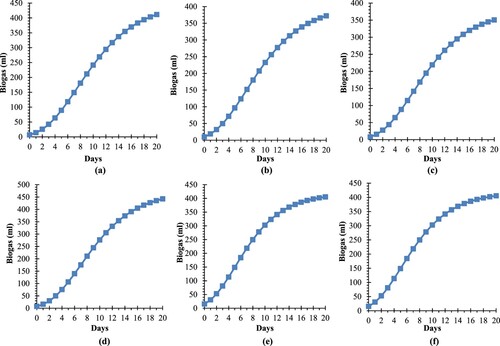
The kinetic parameters of biogas production are shown in Table . The data obtained from the Gompertz equation showed that the Lag phase (λ) is appropriate for the result obtained from co-digestion of cow dung with lignocellulosic biomasses. Table represents a comparison of actual and predicted cumulative biogas production in different samples, and it is evident that both the results are accord with each other.
Table 4. Kinetic parameters calculated using the modified Gompertz model of various samples for Biogas production.
3.3. Correlation analysis
Pearson correlation indicates the interrelationship between selected variables. Thus, to extract the relationships between biochemical composition and the biogas yields of the different digesters, the effect of various parameters is important. As shown in Figure , a sufficient amount of TS or VS leads to a highly positive relationship with COD, TOC, celluloses and hemicelluloses. On the other hand, a high value of TKN shows a quite negative effect on biogas production as it is negatively correlated with TS, VS, COD and TOC. C/N ratio is directly linked with carbon content, i.e. TOC and inversely linked to TKN. This correlation helps understand the composition or constitution of anaerobic digestion slurry to obtain maximum biodegradability. In this context, many researchers have reported a strong correlation between TOC with COD and explained that variability in COD value can be justified with TOC [Citation32,Citation33, Citation34]. To understand different digester’s performance under similar conditions, an ANOVA test was performed using Data Analysis of Microsoft excels. This ANOVA test resulted in statistically significant differences with a significant p-value of 0.05 for co-digestion of cow-dung with wheat straw (A1 + A5) when a 95% confidence level was selected for all statistics. This contributes lignocellulosic biomasses to increase biogas production and biodegradability of animal manure.
4. Conclusions
In this study, cow dung was combined with four substrates for the anaerobic digestion process to analyze the effect of co-digestion in biogas production. Compared to control, co-digested slurry has active colostrums of methanogens, resulting in more depolymerization of substrates. The biodegradability and biogas production from cow-dung co-digested with different waste biomasses has been compared using simple and consolidated methods, which could provide a basic idea of the effect of co-digestion to help determine the best substrate for biogas production. This study also suggests that lignocellulosic biomasses are best for co-digestion with cow-dung for biogas production as these contain higher celluloses and hemicelluloses. The study gives future research opportunities to study the improvement of the biodegradability of lignocellulosic materials using cost-effective co-digestion treatment methods. Biogas production can be enhanced by changing the slurry constituents and composition. Thus, further studies can be done by combining substrates in various ratios.
Informed consent
All authors and co-authors have given their consent to publish the manuscript in this journal.
Acknowledgment
The authors thank Manav Rachna University for the financial support and providing all necessary materials and instruments for conducting the research.
Disclosure statement
No potential conflict of interest was reported by the author(s).
References
- Sharma A, Singh G, Arya SK. Biofuel from rice straw. J Cleaner Prod. 2020;277;1–20. Elsevier Ltd. doi:10.1016/j.jclepro.2020.124101.
- Maroušek J. Pretreatment of sunflower stalks for biogas production. Clean Technol Environ Policy. 2013;15(4):735–740. doi:10.1007/s10098-012-0548-4.
- Zheng Y, Zhao J, Xu F, et al. Pretreatment of lignocellulosic biomass for enhanced biogas production. Prog Energy Combust Sci. 2014;42(1):35–53. doi:10.1016/j.pecs.2014.01.001.
- Kumar V, Kumar P, Kumar P, et al. Anaerobic digestion of azolla pinnata biomass grown in integrated industrial effluent for enhanced biogas production and COD reduction: optimization and kinetics studies. Environ Technol Innov. 2020;17:100627, 1–12. doi:10.1016/j.eti.2020.100627.
- Zhong W, Zhang Z, Luo Y, et al. Effect of biological pretreatments in enhancing corn straw biogas production. Bioresour Technol. 2011;102(24):11177–11182. doi:10.1016/j.biortech.2011.09.077.
- Zhang X, Chen J, Li J. The removal of microplastics in the wastewater treatment process and their potential impact on anaerobic digestion due to pollutants association. Chemosphere. 2020;251. doi:10.1016/j.chemosphere.2020.126360.
- Li Y, Zhang R, Liu G, et al. Comparison of methane production potential, biodegradability, and kinetics of different organic substrates. Bioresour Technol. 2013;149:565–569. doi:10.1016/j.biortech.2013.09.063.
- Elsayed M, Andres Y, Blel W, et al. Effect of VS organic loads and buckwheat husk on methane production by anaerobic co-digestion of primary sludge and wheat straw. Energy Convers Manage. 2016;117:538–547. doi:10.1016/j.enconman.2016.03.064.
- Park KY, Jang HM, Park MR, et al. Combination of different substrates to improve anaerobic digestion of sewage sludge in a wastewater treatment plant. Int Biodeterior Biodegrad. 2016;109:73–77. doi:10.1016/j.ibiod.2016.01.006.
- Shah FA, Mahmood Q, Rashid N, et al. Co-digestion, pretreatment and digester design for enhanced methanogenesis. Renewable Sustainable Energy Rev. 2015;42:627–642. doi:10.1016/j.rser.2014.10.053.
- Kasinath A, Fudala-Ksiazek S, Szopinska M, et al. Biomass in biogas production: pretreatment and codigestion. Renewable Sustainable Energy Rev. 2021;150:111509. doi:10.1016/j.rser.2021.111509.
- Liew ZK, Chan YJ, Ho ZT, et al. Biogas production enhancement by co-digestion of empty fruit bunch (EFB) with palm oil mill effluent (POME): performance and kinetic evaluation. Renewable Energy. 2021;179:766–777. doi:10.1016/j.renene.2021.07.073.
- Potdukhe RM, Sahu N, Kapley A, et al. Co-digestion of waste activated sludge and agricultural straw waste for enhanced biogas production. Bioresour Technol Rep. 2021;15(July):100769. doi:10.1016/j.biteb.2021.100769.
- Prasertsan P, Leamdum C, Chantong S, et al. Enhanced biogas production by co-digestion of crude glycerol and ethanol with palm oil mill effluent and microbial community analysis. Biomass Bioenergy. 2021;148(January):106037. doi:10.1016/j.biombioe.2021.106037.
- Matheri AN, Ntuli F, Ngila JC, et al. Quantitative characterization of carbonaceous and lignocellulosic biomass for anaerobic digestion. Renewable Sustainable Energy Rev. 2018;92(June 2017):9–16. doi:10.1016/j.rser.2018.04.070.
- Wang X, Lu X, Li F, et al. Effects of temperature and carbon-Nitrogen (C/N) ratio on the performance of anaerobic co-digestion of dairy manure, chicken manure and rice straw: focusing on ammonia inhibition. PLoS ONE. 2014;9(5):1–7. doi:10.1371/journal.pone.0097265.
- André L, Pauss A, Ribeiro T. Solid anaerobic digestion: state-of-art, scientific and technological hurdles. Bioresour Technol. 2018;247(September):1027–1037. doi:10.1016/j.biortech.2017.09.003.
- Sidra IK, Shehrbno A, Tamour AC, et al. Production of biogas by the co-digestion of cow dung and crop residue at University of the punjab, lahore, Pakistan. Afr J Environ Sci Technol. 2018;12(2):91–95. doi:10.5897/ajest2017.2446.
- Carrier M, Loppinet-Serani A, Denux D, et al. Thermogravimetric analysis as a new method to determine the lignocellulosic composition of biomass. Biomass Bioenergy. 2011;35(1):298–307. doi:10.1016/j.biombioe.2010.08.067.
- Zhang R, Zhang Z. Biogasification of rice straw with an anaerobic-phased solids digester system. Bioresour Technol. 1999;68(3):235–245. doi:10.1016/S0960-8524(98)00154-0.
- Rani P, Pathak VV, Bansal M. Co-digestion of wheat straw and animal manure pretreated with calcium hydroxide for biomethane production: kinetic study. Curr Res Green Sustainable Chem. 2021;4(June):100145. doi:10.1016/j.crgsc.2021.100145.
- Dębowski M, Janczukowicz W, Zielin M. Biodegradability evaluation of dairy effluents originated in selected sections of dairy production. Bioresour Technol . 2008;99:4199–4205. doi:10.1016/j.biortech.2007.08.077.
- Altas L. Inhibitory effect of heavy metals on methane-producing anaerobic granular sludge. J Hazard Mater. 2009;162:1551–1556. doi:10.1016/j.jhazmat.2008.06.048.
- Bastiaens B, Van den Broeck R, Appels L, et al. Evaluation of the effects of low energetic microwave irradiation on anaerobic digestion. J Environ Manag. 2017;202:69–83. doi:10.1016/j.jenvman.2017.06.062.
- Rajput AA, Zeshan, Visvanathan C. Effect of thermal pretreatment on chemical composition, physical structure and biogas production kinetics of wheat straw. J Environ Manag. 2018;221(April):45–52. doi:10.1016/j.jenvman.2018.05.011.
- Hamidreza S, Hons G. Wheat straw biorefinery for agricultural waste valorisation. Green Materials. 2020;8:60–67. doi:10.1680/jgrma.19.00048.
- Ahmad S, Pathak VV, Kothari R, et al. Prospects for pretreatment methods of lignocellulosic waste biomass for biogas enhancement: opportunities and challenges. Biofuels. 2018;9(5):575–594. doi:10.1080/17597269.2017.1378991.
- Bhatia SK, Jagtap SS, Bedekar AA, et al. Recent developments in pretreatment technologies on lignocellulosic biomass: effect of key parameters, technological improvements, and challenges. Bioresour Technol. 2020;300(October):1142–1156. doi:10.1016/j.biortech.2019.122724.
- Neshat S, Mohammadi M, Najafpour G, et al. Anaerobic co-digestion of animal manures and lignocellulosic residues as a potent approach for sustainable biogas production. Renewable Sustainable Energy Rev. 2017;79;308–322. doi:10.1016/j.rser.2017.05.137.
- Satyanarayan S, Murkute P, Ramakant. Biogas production enhancement by brassica compestries amendment in cattle dung digesters. Biomass Bioenergy. 2008; 32(3):210–215. doi:10.1016/j.biombioe.2007.09.008.
- Muhammad nasir I, Mohd ghazi Ti. Pretreatment of lignocellulosic biomass from animal manure as a means of enhancing biogas production. Eng Life Sci. 2015;15(7):733–742. doi:10.1002/elsc.201500019.
- Dubber D, Gray NF. Replacement of chemical oxygen demand (COD) with total organic carbon (TOC) for monitoring wastewater treatment performance to minimize disposal of toxic analytical waste. J Environ Sci Health - Part A Toxic/Hazard Subst Environ Eng. 2010;45(12):1595–1600. doi:10.1080/10934529.2010.506116.
- Fang C, Huang R, Dykstra CM, et al. Energy and nutrient recovery from sewage sludge and manure via anaerobic digestion with hydrothermal pretreatment. Environ Sci Technol. 2020;54(2):1147–1156. doi:10.1021/acs.est.9b03269.
- El-Mashad HM, Zhang R. Biogas production from co-digestion of dairy manure and food waste. Bioresour Technol. 2010;101(11):4021–4028. doi:10.1016/j.biortech.2010.01.027.

